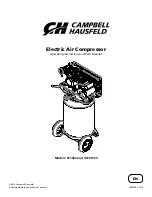
10
HULK Power
4. Insert the power supply cord into the power
supply socket.
5. Turn the pressure switch on, moving the lever
to the AUTO position (fi g 8.1).
6. On the reservoir pressure gauge, you can
watch pressure build in the tank until the pump
stops at the factory-set pressure, about 115 to
125 psi.
7.
This fi rst time running your compressor and
periodically thereafter, check for air leaks. If
the gauge indicates pressure is going down in
the tank or you hear leakage, you could apply
soapy water to all joints in the air transport
piping. Tighten these joints if bubbles form.
Adjusting the air pressure
Your air compressor is supplied with an air pressure
regulator. This regulator adjusts the air pressure
supplied to the hose.
•
To increase air pressure, turn air regulator
knob (fi g 9.10) clockwise.
•
To decrease air pressure, turn air regulator
knob counterclockwise.
• Use the outlet pressure gauge (fi g 9.8) to see
the resulting pressure.
Shutting off your compressor
1. Move the pressure switch clockwise to the OFF
position (fi g 8.0).
2. Unplug the compressor from the electical power.
3. If not draining the tank, reduce tank pressure
through the air hose.
1
0
fig 8
10
8
fig 9
4. Drain the tank by slowly opening the drain valve
(fi g 7.1). Place a catch basin under the valve to
protect the surface from water damage.
Cold Weather Starting
Temperatures below freezing (32 °F / 0 °C) cause
the metal parts of your air compressor to contract
and that makes starting more diffi cult. To assist the
air compressor in starting in cold weather, follow
these tips:
1. Try to keep the air compressor stored in
temperatures above 32 °F (0 °C).
2. Open the air tank drain valve and release all air
pressure from the air tank before attempting to
start in cold weather. (After air is released from air
tank, close drain valve.)
3. Pull the ring on the safety valve before each use
to make sure the valve is functional.
4. Plug the air compressor directly into a 120
volt electrical outlet. Do not use an extension
cord when starting your air compressor in cold
weather.
Maintenance
Daily
●
Before each use,
1. check for any unusual noise or vibration.
2. be sure all nuts and bolts are tight.
●
After each use, drain condensation from the air
tank.
Monthly
●
Inspect air system for leaks by applying soapy
water to all joints. Tighten these joints if leaks
are discovered.
Storage
When storing your compressor:
1. Be sure the unit is turned OFF.
2. Unplug it from power source.
3. Rotate the regulator to set the outlet pressure to
zero.
4. Release air pressure from all hoses and air
tank(s).
5. Drain all moisture from air tank(s).
6. Fully close drain valve(s).
7. Protect electrical cord and air hoses from damage
(such as being stepped on or driven over). Wrap
all cords and hoses loosely around the (cooled)
air compressor.
8. Place air compressor in a cool, dry, safe, and
indoor location.











































